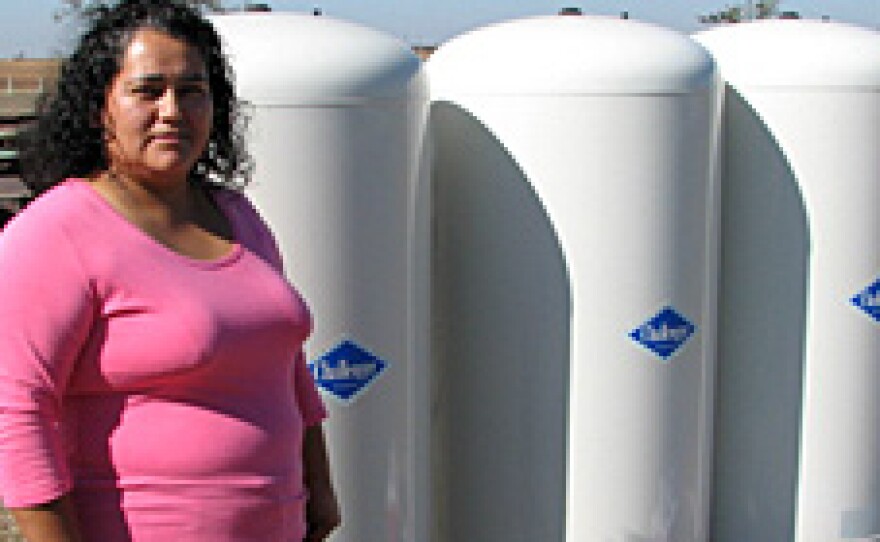California is facing a hidden threat to its drinking water supply. Nitrate pollution is a problem for both cities and rural areas, and it could get worse as the state's population grows. Yet, regulators aren't really paying attention.
THE CALIFORNIA REPORT SPECIAL SERIES
Part 2: Nitrates in Our Drinking Water - Charting a Cleaner Future
Part 3: Nitrates in Our Drinking Water- Cleaning up the Past
A DREAM HOME TURNS INTO A NIGHTMARE
When Ana Vargas and her husband built their four-bedroom dream home, they chose a large plot of land in rural Tulare County, on what used to be an alfalfa field. They angled the living room and master bedroom toward a panoramic view of the Sierra Nevada.
"We moved here thinking, if we left the city, everything would be better, more peaceful. Cleaner air, cleaner water. But we've found out that's not true," says Vargas.
The Vargases are among a growing number of Californians whose drinking water is polluted with nitrates -- colorless and odorless contaminants that can cause health problems. Nitrates are linked to blue-baby syndrome, a condition that cuts off oxygen to the organs of fetuses and infants. Some animal studies have also linked nitrates to increased cancer risk, although there's no conclusive evidence in humans.
This kind of pollution is acute in the Central Valley. In fact, in the eastern San Joaquin Valley, one out of three domestic wells test high for nitrates. Researchers' maps show agricultural areas with a history of heavy fertilizer use have some of the worst nitrate contamination problems.
Last year, the Vargas family volunteered to get their well tested by the state. The results came in high above what the EPA considers safe for drinking water.
Ana Vargas was pregnant when she moved to their house, and had three other young children. They haven't suffered any notable health problems, but the family is still worried.
These days, Vargas sends her children to school every day with bottled water -- which is what her family drinks at home, too. She also recently stopped cooking with tap water when she learned boiling nitrates can concentrate them, making them more potent.
WHAT ARE NITRATES?
Nitrates are a salt -- they're a byproduct of fertilizer, dairy farms, and leaky septic tanks. They often leach into groundwater.
State records show over the last fifteen years, nitrates have contaminated public drinking water sources for more than two million Californians in both urban and rural areas. Although cities are required to remove nitrates before they reach the tap, many communities don't have access to that kind of cleanup technology.
That's true in rural Tulare County, where the Vargas family lives. Pointing to the rows of orange and olive trees that surround her property, Ana Vargas says it makes her mad that farmers don't have any rules limiting how much fertilizer they can put on their land.
"They have to think about who's living around the fields, and who's drinking the water that's contaminated by what they feed their plants," she says.
In 2008, California farmers applied 855,000 tons of nitrogen fertilizer to farmland across the state. Depending on the crop, scientists say plants can take up less than half that fertilizer, leaving the rest to evaporate or seep into the ground.
"What has happened is that as that fertilizer use has increased, the concentrations in the groundwater have increased," explains Karen Burow, a scientist with the US Geological Survey in Sacramento.
Burow has found that most of the nitrate concentration from fertilizer applied over the last 50 to 60 years is affecting groundwater in shallower private wells, like the one the Vargases use. But nitrates are starting to leach down further to the deeper groundwater that supplies municipalities and cities.
"So we are seeing increases deeper in the system, and the question will be, how long is it going to take until that really high concentration of water gets down deeper in the system, and are we going to effectively fill up the bathtub with nitrate concentrations?" says Burow.
WHAT'S BEING DONE?
Problems with nitrates could get worse as California's population swells.
"We're growing at a pace of about a half a million a year, so we're looking at a population of 50 million by somewhere mid-century," predicts Ellen Hanak of the nonprofit think tank the Public Policy Institute of California. Hanak's research focuses on how the state will meet its water needs.
Hanks continues, "About half of that growth is going to be in the inland areas, including San Joaquin Valley, Inland Empire, and Sacramento Valley. All places that rely heavily on groundwater."
So far, regulators haven't done much to force farmers and the industry to clean up nitrates. State and regional water boards almost never issue fines or shut down farms and dairies found responsible for nitrate pollution.
State water regulators say nitrates are not as urgent a priority as other contaminants that cause severe health effects, like perchlorate or dry cleaning chemicals. Darrin Polhemus, head of the water quality division of the State Water Board, defends the inaction: "On the scale of things we deal with, while nitrates is certainly a concern, and we're managing for it, I don't rank it high up there as something that makes me stay awake at night."
But that's no comfort to Ana Vargas. Knowing her well is contaminated means her family must rely on bottled water, because they can't trust one of the most basic necessities -- the water from their tap.






